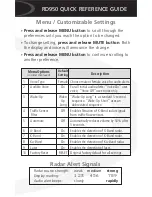
SR2
–
19
72. Install the battery clamp. Position battery and holder so as not to
cover nearby PC board mounting holes. Use the method for securing the
clamp that is most convenient for you, such as:
•
wire looped through clamp and PC board holes, soldered.
•
small screws
•
double-faced adhesive strips
•
hot-melt glue
73. If you desire increased audio output, C27, 10 µF, may be installed.
Be sure the (+) and (-) leads are inserted correctly.
74. We’re at the end now, just one part left to install. Install D2, the red
LED signal indicator. The short lead is the cathode; it goes toward
potentiometer R21. Leave it standing about 1/2 an inch off of the board
when soldering. After soldering bend it over to a 90º angle at its midpoint
so that it faces the outside of the board.
Your shortwave broadcast receiver is now finished, except for the capacitors
that will determine the frequency range you will receive.
SHORTWAVE ANTENNA IDEAS
The type of antenna you'll want to use for your SR2 depends on the degree
of interest you have in shortwave listening, whether you are limited to an
indoor or balcony antenna, and whether you think you may soon want to
obtain a HAM radio license. If the latter is true, you may want to consult
HAM radio literature and build the dipole or vertical antenna which you also
plan to use for HAM listening and transmitting. A 40-meter (7 MHz) antenna
is quite nice for the tuning range of the SR2.
The rest of these notes on antennas are for the benefit of SR2 builders who
simply wish to enjoy some shortwave broadcast listening. The SR2 is very
sensitive, so its antenna requirements are minimal for casual evening
listening when international broadcast signals are quite strong. 10 to 20 feet
of insulated hookup wire can be neatly strung behind furniture and curtains
for an adequate indoor antenna. The same length of wire, or more, outdoors
or up in the attic, will be an even better receiving antenna.
1. The ideal antenna setup for this frequency range is considered to be an
outdoor wire 25 to 50 feet in length, with the ground side of the
antenna jack connected to a copper cold water pipe.
2. For convenience, a short length of audio cable with pre-wired RCA plug is
adequate for making antenna and ground connections. (RF coaxial
cable is not essential for this application).
3. A "banana plug" may also be plugged into the antenna jack but will not










































